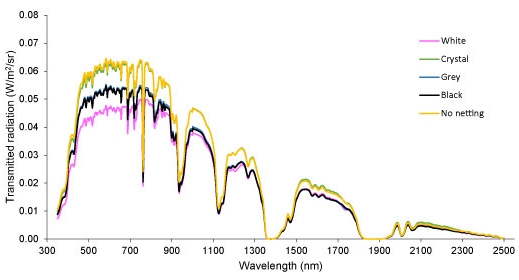We tested four netting types: a white HDPE knitted net and black, grey and crystal HDPE extruded nets. All three extruded netting had the same fibre diameter and density.
Wavebands corresponding to solar radiation (350– 2500 nm), ultraviolet A radiation (350–400 nm), photosynthetically active radiation (400–700 nm) and infrared radiation (700–2500 nm) were extracted.
The light that got through
Overall, solar radiation was reduced by approximately 23, 18, 15 and 5 per cent by the white, black, grey and crystal netting, respectively.
The white netting reduced the most radiation attributed to the higher weave density, however, the transmission of radiation through the white (and the crystal to a lesser extent) varied with wavelength.
Ultraviolet A, photosynthetically active and infrared radiation were reduced by 34, 28 and 19 per cent, respectively, by the white netting. By contrast, the black netting reduced ultraviolet A, photosynthetically active and infrared radiation by 20, 19 and 18 per cent, respectively.
When the plane of the netting was approximately perpendicular (i.e. 72°) to the solar beam—which is similar to the solar angle in relation to flat roofed netting in mid-summer at midday—incoming solar radiation (i.e. no netting) peaked at wavelengths from 450–900 nm and then steadily declined to 2500 nm with several troughs at approximately 950, 1150, 1400 and 1900 nm (see Figure 2).
The effects of grey and black netting on the proportion of solar radiation that was transmitted were similar and did not vary with wavelength whereas the white netting varied with wavelength. The crystal netting had very little impact on incoming solar radiation. (cont next month)
See this article in Tree Fruit Oct 2018




















